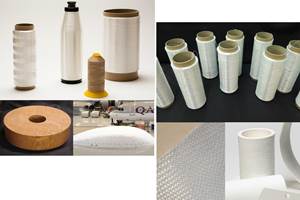High-temperature, fire-resistant materials bridge CFRP and CMC gap
CAMX 2024: Pyromeral Technology features its Pyromeral family of fiber-reinforced materials — PyroKarb, PyroSic and PyroXide — with novel ceramic matrices achieving high-temperature capabilities.
Share
For 40 years, Pyromeral Technology (Barbery, France and Sunnyvale, Calif., U.S.) has been developing innovative materials and composite parts to meet the challenges of high-temperature and fire-resistant applications. The company highlights these capabilities through the Pyromeral family of materials.
Pyromeral composite materials, marketed under PyroKarb, PyroSic and PyroXide, feature proprietary ceramic matrices that are derived from alumino-silicate-based geopolymeric systems. According to the company, they differ significantly from organic polymers and conventional ceramic matrices in that they can be processed with a low-temperature autoclave cure and one free-standing post-cure. This not only reduces lead times and complexity to produce high-temperature composite parts, but also improves affordability.
These materials are meant to bridge the thermal, structural and cost gap between carbon fiber-reinforced polymers (CFRPs) and traditional traditional ceramic matrix composites (CMC). They bring a lightweight and convenient alternative to metals and other materials for heat shields, ducts and other components exposed to sustained temperatures from 177°C to 1000°C and beyond for short-term exposure.
PyroKarb, presented to industry in 2000, features a high-modulus carbon fiber fabric with a glass-ceramic matrix, and a silicon-carbide fabric with the same matrix for PyroSic. Both materials are said to offer performance well beyond the capability of polyimides, to 800°C and higher. PyroKarb saves 40% weight compared to aluminum and PyroSic saves 60% compared to titanium.
PyroXide was introduced in 2013 using an aluminum-oxide fabric with a novel oxide-ceramic matrix, pushing temperature capability to 1000°C and beyond, with 70% weight savings compared to Inconel.
Today, Pyromeral materials are used across a wide array of industries ranging from heat shields on engines, supersonic and hypersonic fins and external skins in aerospace and defense, and battery thermal runaway protection and containment in the advanced air mobility market.
Pyromeral Technology held the grand opening of its standalone U.S. headquarters on May 23, 2024, in Sunnyvale, California. The ITAR-registered facility is set to offer full material prepreg production and part fabrication capabilities, bringing the benefits of its thermal management solutions to a wider range of customers and applications.
Related Content
-
SRI advances CMC for solar, renewable energy and industry
U.S. research institute advances “infiltration-free” process for improved performance, durability and affordability of materials able to withstand highly corrosive environments at temperatures beyond 700°C.
-
DITF Denkendorf advances sustainable carbon fibers, oxide fibers for CMC and more
The German Institutes of Textile and Fiber Research are targeting more sustainable carbon fiber via low-pressure stabilization and bio-based precursors, and working with Saint-Gobain to commercialize oxide ceramic fibers for CMC.
-
The future of quartz and oxide fibers at Saint-Gobain Advanced Ceramic Composites
New business builds on 100-year legacy in quartz, prepares for growth, while starting production of oxide fibers to meet increased demand for CMC by aerospace and industrial sectors.
Related Content
SRI advances CMC for solar, renewable energy and industry
U.S. research institute advances “infiltration-free” process for improved performance, durability and affordability of materials able to withstand highly corrosive environments at temperatures beyond 700°C.
Read MoreDITF Denkendorf advances sustainable carbon fibers, oxide fibers for CMC and more
The German Institutes of Textile and Fiber Research are targeting more sustainable carbon fiber via low-pressure stabilization and bio-based precursors, and working with Saint-Gobain to commercialize oxide ceramic fibers for CMC.
Read MoreThe future of quartz and oxide fibers at Saint-Gobain Advanced Ceramic Composites
New business builds on 100-year legacy in quartz, prepares for growth, while starting production of oxide fibers to meet increased demand for CMC by aerospace and industrial sectors.
Read MoreORNL, Sierra Space create novel C/SiC TPS for reusable space vehicles
CMC tiles will be used on the Sierra Space DC100 Dream Chaser spaceplane carrying critical supplies and science experiments to and from NASA’s ISS.
Read MoreRead Next
Quartz, CMC and ceramic continuous filament offerings
CAMX 2024: Saint-Gobain Quartz, now Saint-Gobain Advanced Ceramic Composites, diversifies its portfolio of high-temperature materials development for aerospace, connectivity and industrial markets.
Read MoreBridging the gap between CFRP and CMC
Novel composites offer performance up to 1000°C with faster processing.
Read MoreAll-recycled, needle-punched nonwoven CFRP slashes carbon footprint of Formula 2 seat
Dallara and Tenowo collaborate to produce a race-ready Formula 2 seat using recycled carbon fiber, reducing CO2 emissions by 97.5% compared to virgin materials.
Read More













